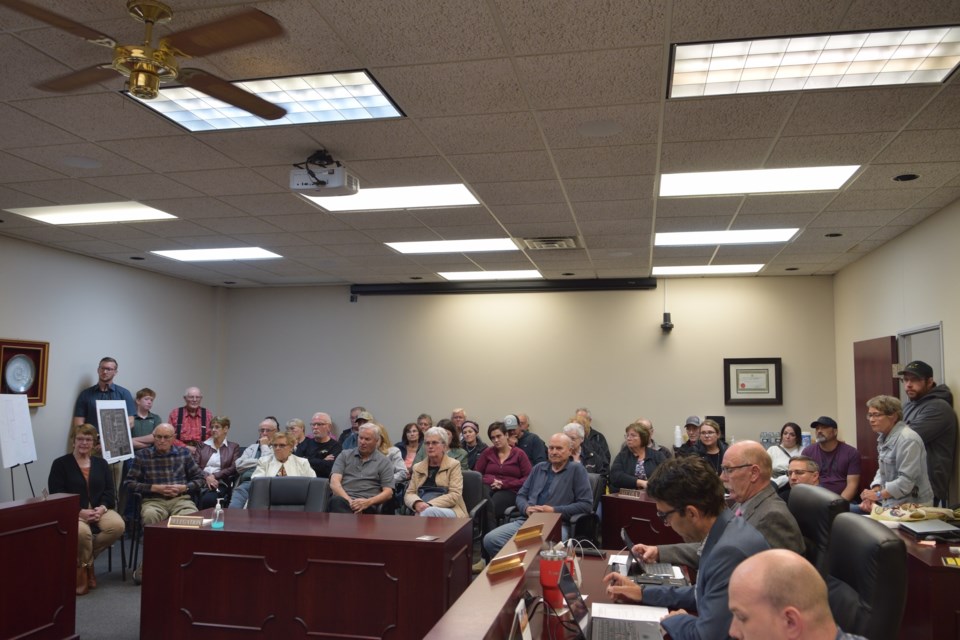BARRHEAD - Town of Barrhead councillors have shelved plans to rezone multiple properties in Beaver Brooke Estates to allow higher-density housing options.
Mayor Dave McKenzie announced just before the start of a Dec. 8 public hearing that council had decided to put on the brakes on a bylaw that would have seen the rezoning of six lots on 61st Street from from R1 to R3.
R1-residential allows for low-density housing, such as single-detached dwellings, while R3 provides various housing options, such as duplexes, triplexes, fourplexes, and rowhouses.
"Because of the dialogue we've been having with the ratepayers, more information and concepts have come forward, and as a result, council will not be passing the bylaws tonight and will be tabling them indefinitely," he told a public gallery of between 30 to 40 people. "We've [taken those converstations] to heart and have engaged experts to give us some ideas about urban development and planning, which we want to explore."
McKenzie added that, as the council said, any comments at the public hearing would be moot, noting that if or when similar bylaws come along, the process would essentially start over.
However, he said, the public hearing on the Beaver Brook Estates area structure plan would go forward despite that.
Later, following the public hearing, councillors officially rescinded the land-use bylaw (LUB) and the area structure plan bylaw.
An area structure plan provides a general overview of the use of a particular area.
Councillors gave the LUB the first reading on July 9 and held the subsequent public hearing on Aug. 13. Council gave first reading to the area structure plan bylaw on Sept. 10.
Public comments
Ard Doornboss, a Beaver Brook Estates resident, asked if the municipality would rezone other vacant lots if they hosted a question-and-answer session, which he felt was lacking for this pair of bylaws.
McKenzie said yes but took issue with the municipality's not hosting such a session, referring to the Oct. 2 public information session at the Charles Godberson Rotary Room.
"I can't say we got any questions well answered," interjected another resident. "We got form letter responses. If there were one weakness, I would have to say it was communication," he said.
John and Susan Turner, who live about two blocks from the properties to have been rezoned, stated in a letter that CAO Edward LeBlanc read that they bought their home on the "clear understanding" that the subdivision was for single-family homes.
"This proposal undermines this promise by introducing multi-family and possibly low-income or rental dwellings," they said.
The Turners expressed concern that introducing higher-density housing would risk the "cohesive character" of the neighbourhood and potentially lower property values.
They also alternatively suggested that if the municipality wanted to increase the housing available in the subdivision, it should attract single-family development.
The Turners said the municipality could do that by improving the amenities in the subdivisions, such as adding water features, parks and playgrounds.
LeBlanc also read a letter from Doornboss, who stated that he attended the Aug. 13 public hearing and the subsequent information session and still opposed the rezoning for multiple reasons, including parking on nearby 62nd Street.
"Putting a row of 12 to 18 residences on these six lots will cause a parking nightmare for current and future residents," Doornboss said.
Doornboss added that at the public information session, they were told Barrhead's vacancy rate was about one per cent.
"There is a serious shortage of housing. Does the town council think putting up 12 residences will relieve the housing pressure?" he asked.
A recent newcomer, Matthew, questioned how tight Barrhead's housing market was.
"We keep being told there is a lot of demand and no supply," he said. "If that were true, prices would reflect that. When you compare it to B.C. or other places in Alberta, home prices in Barrhead are quite low. Most homes we saw coming on the market were under $250,000. There is a lot of low-income housing in Barrhead."
He also questioned how row housing, which he understands would sell for $350,000-$450,000.
"I fail to see how these row houses will be a low-income solution unless they are government-subsidized rentals, which will definitely jeopardize the market," Matthew added. "There are much better places in the community [for higher density development], and in the long run, I think it jeopardizes a valuable neighbourhood that attracts people to our community."
Another resident, Jared, added that he disagreed with the council's comments at the previous public hearing and the information session that the town was "landlocked."
"The reality is the land is undeveloped, and you have property allocated for higher density," he said. "I hope it never develops, but I knew that when I bought, but I knew it was a possibility. That is the honest way. If you want higher density, put it where you said you would."
Barry Kerton, TownandCountryToday.com



